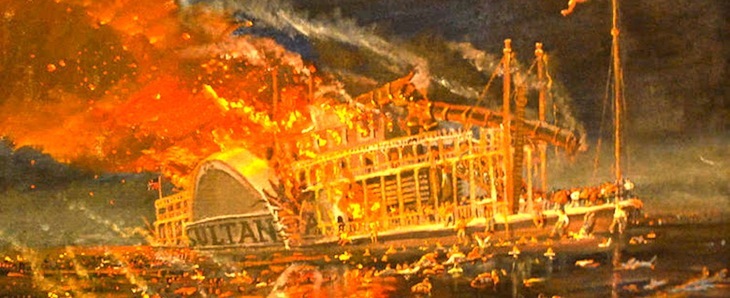Greatest maritime disaster in U.S. history may become tourist draw in Northeast Arkansas
by August 20, 2017 7:45 pm 4,049 views

A calculated mistake by President Abraham Lincoln led to the most horrific maritime disaster in United States history, and it may turn into a tourism site in Marion and surrounding communities in Crittenden County.
Plans are underway to build the $3 million Sultana Disaster Museum, Project Director Louis Intres told Talk Business & Politics. About 1,200 Union soldiers died when their boat, the Sultana, caught fire April 27, 1865, about seven miles north of Memphis on the Mississippi River. The Sultana rests underneath a soybean field in Marion.
“This is an incredible, important story,” Intres said. “It’s a Civil War story. It’s an American story. It’s never gotten its historical due. There were soldiers on that boat who had hope in their heart … they were betrayed.”
The Marion Advertising and Promotion Commission has dedicated $400,000 toward the construction of the proposed 10,500-square-foot museum, and has promised another $75,000 per year for 10 years to be used for operations. A feasibility study commissioned by the city of Marion estimates up to 40,000 visitors per year could be lured to the city.
Economic benefits could by significant, Intres said. The report states $2.4 million in economic activity could be generated, adding $200,000 per year to the tax base. Tourists would spend $763,636 on hotel/lodging costs; $664,275 on food; $347,000 on retail; $318,525 on admissions/entertainment; $134,610 on fuel; and the rest will be spent on miscellaneous items.
TRAGEDY ROOTED IN CORRUPTION
The Sultana was a paddle wheel steamboat commissioned in 1863 on the Mississippi River during the Civil War, according to historians. It had a maximum capacity of 376 passengers. The boat ultimately ended up in Vicksburg, Mississippi at the war’s close. The chief quarter master at Vicksburg, Lt. Reuben Hatch, had a military past filled with corruption. He was from Illinois and had a powerful ally who secured his position at Vicksburg – President Lincoln.
Hatch was facing a court-martial tribunal for taking bribes during a stint as the quarter master in Cairo, Ill. His brother O.M. Hatch was a financial backer of Lincoln, and before the court martial took place, the sitting president sent the judge a letter that ultimately led to the dismissal of charges. Hatch then made his way south.
The Sultana arrived in Vicksburg on April 23, 1865, just days after the war had ended and Lincoln had been assassinated. Thousands of Union prisoners of war needed to be transported back to their homes. Many were sick and emaciated. Some had to be carried onto the boat, because they didn’t have the strength to do it themselves, Intres said.
Greed compelled Hatch to place more than 2,000 soldiers on the Sultana instead of dividing the soldiers between it and another available transport boats, but at the behest of Hatch, those efforts were refused. Loaded six times beyond its capacity wasn’t the only problem the Sultana faced. Her boilers were severely damaged and were in need of repair.
Despite those factors, she began the churn north at 9 p.m. that night in the flood swollen river headed for Cairo, Illinois. Three boilers exploded late night three days later. The hot coals and scolding water and fire killed hundreds in the moments following the initial blast. Marion residents, other boats along the river attempted to save soldiers who were thrown into the chaotic waters. A sailor aboard the U.S.S. Tyler wrote in the ship’s log that “Of all the sounds and noises I ever heard that was the most sorrowful; some cursing, calling for help; and shrieking. I will never forget those awful sounds,” according to history.net.
‘HOPE IN THEIR HEARTS’
For many years it was believed up to 1,800 soldiers were killed that night, making a worse tragedy than the sinking of the Titanic in 1912. Recent research indicates the number is closer to 1,200, which means more were still killed on the Sultana than killed on the U.S.S. Arizona during the attack on Pearl Harbor, Dec. 7, 1941.
Intres, a retired banker and Arkansas State University professor, traveled through the Middle East writing about the grave robbing industry. During his career as a banker and professor he raised hundreds of thousands of dollars for the ASU athletics program. His goal now is to raise enough money to build the museum. The goal is to have enough money to begin construction within the next three years. There were only 11 battles during the war in which more men died, and Arkansas’ most significant Civil War event needs a museum to commemorate those who perished, he said.
“These men finally had a little hope in their hearts. … They’d survived the brutalities of war … they thought they were on their way home,” he said. “Many of them never made it.”
